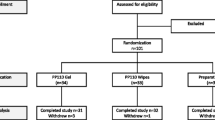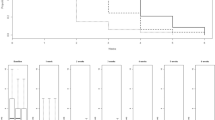Abstract
Topical formulations are widely used in anti-haemorrhoidal treatment, but often lacking controlled clinical trials. Here, we report the results from a controlled clinical trial performed with a new gel medical device (Proctoial) containing hyaluronic acid with tea tree oil and methyl-sulfonyl-methane as major components. The total number of 36 haemorrhoidal patients (grade 1–3) was enrolled in a double-blind, placebo-controlled clinical trial and divided into 2 equal parallel groups. The anal pain, pain during defecation, visible bleeding, pruritus and irritation/inflammation were recorded before and after 14-day treatment using a visual analogue scale both by the investigators and by the patients. Safety and tolerability of the treatments were also recorded. The new gel medical device statistically significantly reduced all the symptoms after the treatment compared to placebo. The results indicated also a very good tolerability and safety of the treatments.





Similar content being viewed by others
References
Acheson AG, Scholenfield JH (2008) Management of haemorrhoids. BMJ 336:380–383
Nisar PJ, Scholenfield JH (2003) Managing haemorrhoids. BMJ 327:847–851
Hancock BD (1992) Haemorrhoids. BMJ 304:1042–1044
Willis S et al (2010) Haemorrhoids a collagen disease? Colorectal Dis 12:1249–1253
Lupo MP (2006) Hyaluronic acid fillers in facial rejuvenation. Semin Cutan Med Surg 25:122–126
Laurent TC, Fraser JRE (1992) Hyaluronan. FASEB J 6:2397–2404
Volpi N et al (2009) Role, metabolism, chemical modifications and applications of hyaluronan. Curr Med Chem 16:1718–1745
Kim YO et al (2009) The anti-inflammatory effects of methylsulfonylmethane on lipopolysaccharide-induced inflammation responses in murine macrophages. Biol Pharm Bull 32(4):651–656
Carson CF et al (2006) Melaleuca alternifolia (Tea Tree) oil: a review of antimicrobial and other medicinal properties. Clin Microbiol Rev 19((1):50–62
Papadopoulos CJ et al (2006) Susceptibility of pseudomonas to Melaleuca Alternifolia (tea tree) oil and components. J Antimicrob Chemother 58:449–451
Burdick JA, Prestwich GD (2011) Hyaluronic acid hydrogels for biomedical applications. Adv Mater 23(12):H41–H56
Dechert TA et al (2006) Hyaluronan in human acute and chronic dermal wounds. Wound Rep Reg. 14:252–258
Parcell S (2002) Sulphur in human nutrition and applications in medicine. Altern Med Rev. 7(1):22–44
Fernandez Garcia MI et al (2009) Efficacy and safety of topical diltiazem 2% in anal fissure. Farm Hosp 33(2):80–88
Perrotti P et al (1999) Topical nifedipine for conservative treatment of acute haemorrhoidal thrombosis. Colorectal Dis 2:18–21
Gioiella G et al (2004) Clinical study on the pharmacological treatment of haemorrhoids with 0.25% oxethacaine chlorhydate. Clin Ter 155(10):443–445
Tjandra JJ et al (2007) Rectogesic (glyceryl trinitrate 0.2%) ointment relieves symptoms of haemorrhoids associated with high resting anal canal pressures. Colorectal Dis 9(5):457–463
Perrotti P et al (2010) Topical nifedipine with lidocaine ointment versus active control for pain after hemorrhoidectomy: results of a multicentre, prospective, randomized, double-blind study. Can J Surg 53(1):17–23
Conflict of interest
None.
Author information
Authors and Affiliations
Corresponding author
Rights and permissions
About this article
Cite this article
Joksimovic, N., Spasovski, G., Joksimovic, V. et al. Efficacy and tolerability of hyaluronic acid, tea tree oil and methyl-sulfonyl-methane in a new gel medical device for treatment of haemorrhoids in a double-blind, placebo-controlled clinical trial. Updates Surg 64, 195–201 (2012). https://doi.org/10.1007/s13304-012-0153-4
Received:
Accepted:
Published:
Issue Date:
DOI: https://doi.org/10.1007/s13304-012-0153-4




